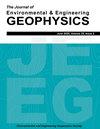Seismic Shear-Wave Characterization of Sand and Gravel Groundwater Aquifers in Northern Illinois
IF 0.7
4区 工程技术
Q4 ENGINEERING, GEOLOGICAL
引用次数: 0
Abstract
Groundwater is a nearly exclusive water resource, specifically for the communities which are part of the Chicago metropolitan area. However, water shortage is predicted for many communities in this region, and demand for locating and delineating groundwater is increasing to fulfill the water supply. Shallow sand and gravel aquifers within the glacial deposits of the area specifically are high volume aquifer and less stressed compare to deeper bedrock aquifer. Yet, these aquifers are poorly understood in terms of their extent and lateral variability. This study applied the shear-wave seismic reflection method to delineate the thickness, lateral extent, and internal variability of these aquifers. We acquired horizontally polarized shear-wave (SH-waves) reflection data along five profiles of a total length of 11 km using the land streamer technology in McHenry County in northern Illinois to delineate sand and gravel aquifers. As shear waves propagate through the rock matrix and less sensitive to the presence of water, information from nearby borings and water wells aided the interpretation of the acquired SH-wave seismic profiles. We delineated multiple sand and gravel units of potential aquifers of different thicknesses and lateral extent along with the seismic profiles. The relatively higher vertical and lateral resolution of the shear-waves reflection method and its insensitivity to water saturation or chemistry made it an ideal method to resolve sand and gravel units of potential aquifers within the complex geological environment if aided by water-well information.北伊利诺斯州砂石地下水含水层的地震剪切波特征
地下水是一种几乎独一无二的水资源,特别是对芝加哥大都市区的社区来说。然而,该地区许多社区预计将面临水资源短缺,为满足供水需求,对地下水定位和圈定的需求正在增加。该地区冰川沉积物中的浅层砂砾含水层是高容量含水层,与较深的基岩含水层相比,应力较小。然而,人们对这些含水层的范围和横向变异性了解甚少。本研究采用横波地震反射法来描绘这些含水层的厚度、横向范围和内部变异性。我们利用陆地拖缆技术,在伊利诺伊州北部的McHenry县沿5条总长度为11公里的剖面获取了水平偏振横波(sh波)反射数据,以圈定砂石含水层。由于横波在岩石基质中传播,对水的存在不太敏感,来自附近钻孔和水井的信息有助于解释所获得的sh波地震剖面。根据地震剖面,圈定了多个不同厚度、不同横向范围的潜在含水层砂砾石单元。横波反射法具有较高的纵向和横向分辨率,且对含水饱和度和化学性质不敏感,在水井信息的辅助下,是复杂地质环境下潜在含水层砂砾单元解析的理想方法。
本文章由计算机程序翻译,如有差异,请以英文原文为准。
求助全文
约1分钟内获得全文
求助全文
来源期刊

Journal of Environmental and Engineering Geophysics
地学-地球化学与地球物理
CiteScore
2.70
自引率
0.00%
发文量
13
审稿时长
6 months
期刊介绍:
The JEEG (ISSN 1083-1363) is the peer-reviewed journal of the Environmental and Engineering Geophysical Society (EEGS). JEEG welcomes manuscripts on new developments in near-surface geophysics applied to environmental, engineering, and mining issues, as well as novel near-surface geophysics case histories and descriptions of new hardware aimed at the near-surface geophysics community.
 求助内容:
求助内容: 应助结果提醒方式:
应助结果提醒方式:


